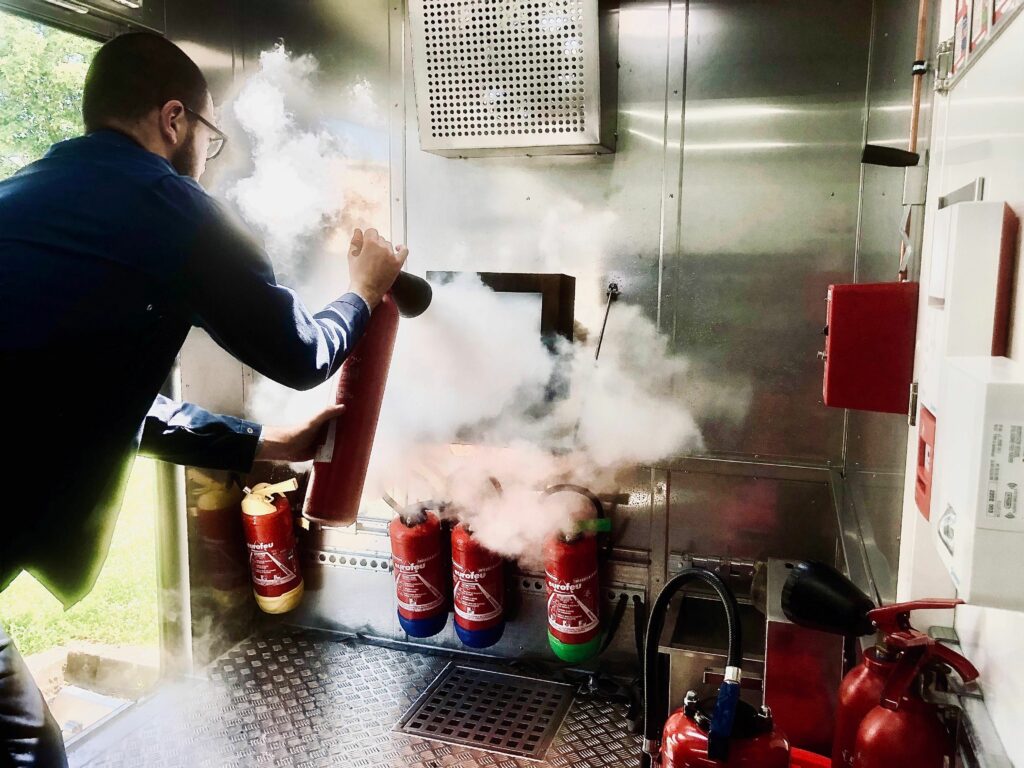Who can use a fire extinguisher?

Fire regulations are clear: the use of a fire extinguisher is not restricted to certain individuals. Indeed, all company personnel can be trained to handle this safety tool. However, precise rules dictate its installation, such as the need for one extinguisher for every 200m² of floor space. In addition, public transport vehicles and heavy goods vehicles require specific equipment. Compliance with these standards is essential for fire safety.
General regulations on the use of fire extinguishers
Standards and legal requirements
To guarantee fire safety, standards require every building to be equipped with fire extinguishers that comply with current regulations. This includes a water-spray extinguisher of at least 6 liters for every 200 m² of floor space and every level.
Obligations vary according to the type of establishment:
- Companies must install fire extinguishers adapted to the specific risks on their premises.
- For establishments open to the public, regulations also require clear signage for each extinguisher.
The law also requires regular checks to ensure that they are in good working order. Annual maintenance is mandatory, in accordance with standard NF S 61-919.
Non-compliance may result in sanctions, underlining the importance of respecting these rules to avoid any risk of fire.
Regulations under the French Labour Code
To meet the requirements of the Labor Code, the employer must ensure the presence of a sufficient number of fire extinguishers. They must be adequately distributed throughout the work premises to ensure rapid intervention in the event of fire. Fire extinguishers, with a minimum capacity of 6 liters, must be placed every 200 m² and on every level.
Regular maintenance is imperative to guarantee their efficiency. An annual inspection is required to check their condition. In addition to maintenance, article R.4227-39 stipulates that personnel must be trained in the use of fire extinguishers. Such training must take place every six months. Exercises include the practical use of extinguishers on a real fire, ensuring that all employees know how to intervene in an emergency situation. Compliance with these standards is essential for everyone's safety.
Safety rules to be observed during use
When using an extinguisher, a number of precautions must be taken to ensure safety. Before any intervention, make sure you know the type of fire you'll be fighting, and use the appropriate extinguisher. It's crucial to maintain a safe distance of about one meter when activating the device.
Be sure to identify nearby emergency exits for rapid removal if necessary. When using, hold the extinguisher vertically and press the handle to release the extinguishing agent. Direct the spray towards the base of the flames, using a sweeping motion to cover the entire burning surface.
After use, lay the extinguisher flat and notify the safety department for replacement or servicing. These steps will ensure an effective response and minimize risks.
What is a hydrant?
Hydrants are essential to fire safety. They enable firefighters to connect quickly to the water supply network, and ensure they have sufficient water to extinguish a fire. Hydrants are installed in both urban and rural areas, following strict accessibility rules.
To guarantee their effectiveness, bollards need to be kept in good condition. Here are a few key points concerning their maintenance and use:
- Accessibility: They must be kept clear of all obstacles.
- Regular checks: The municipality is responsible for ensuring that they are working properly.
- Controlled use: Their use is strictly reserved for emergency situations and network maintenance.
By complying with these instructions, hydrants play a crucial role in protecting people and property.
Who is authorized to use a fire extinguisher?
The use of extinguishers in the workplace
The use of fire extinguishers in the workplace is essential to prevent fires. All employees must be trained in their use, ensuring a rapid response in the event of an emergency. Training should cover the different types of extinguishers, such as powder or CO2, and their application to different classes of fire.
To enhance safety, fire extinguishers must be easily accessible and properly marked. Make sure every employee knows where fire-fighting equipment is located and how to use it. Here are some points to check:
- Accessibility: Fire extinguishers must be placed in a visible location.
- Signage: Use clear signs to indicate their location.
- Ongoing training: Organize training sessions every six months.
By following these guidelines, a company can significantly reduce the risk of fire.
The role of the safety officer in the use of fire extinguishers
The safety manager plays an essential role in the management of fire extinguishers within a company. He or she must ensure that all employees receive comprehensive training in the use of fire extinguishers, which is a legal obligation under the French Labor Code. This training must include the key steps:
- Recognize the type of fire
- Choosing the right extinguisher
- Correctly apply the sweeping technique at the base of the flames
He is also responsible for ensuring that fire extinguishers are regularly maintained and checked, guaranteeing their effectiveness in the event of an emergency. The signage of safety equipment, as well as its accessibility, must be checked to enable rapid intervention. In the event of fire, an immediate and adequate response is essential to protect both people and property.
Fire training: who should attend?
All company employees are required to take part in fire training, whether or not they are in direct contact with high-risk equipment. This training includes practical exercises to reinforce the ability to react quickly to a fire outbreak. The main groups concerned are
- Employees working in high-risk environments: such as industrial sectors or laboratories, where handling flammable materials is commonplace.
- General staff: even in conventional offices, it's essential that everyone knows how to use a fire extinguisher and recognize alarm signals.
- New arrivals: every new employee must undergo this training as soon as they arrive, to ensure consistent safety throughout the company.
By taking part in these sessions, employees acquire the skills they need to use extinguishers effectively, thereby reducing the risk of fire and ensuring the safety of everyone in the workplace.
Using fire extinguishers in different locations
Are fire extinguishers compulsory in vehicles?
Although French legislation does not require the presence of a fire extinguisher in private cars, owning one can be a good idea. For professional vehicles, however, the installation of a fire extinguisher is mandatory. This applies in particular to vehicles used to transport goods or people.
It's advisable to opt for a 2 kg powder extinguisher, ideally placed in the passenger compartment for quick access. Here are a few reasons why you should buy a fire extinguisher for your car:
- Increased safety: Extinguishing an outbreak of fire quickly can limit material damage and prevent injury.
- Risk prevention: Vehicles, whether thermal or electric, can be prone to fire.
Although not compulsory, a fire extinguisher is a valuable safety feature in your vehicle.
Specific standards for ERP (Etablissements Recevant du Public)
When it comes to public buildings, it's essential to comply with strict fire safety standards. Every ERP must be equipped with fire extinguishers adapted to the type of risk present. For example, a 6-liter water-spray extinguisher is required for each level and every 200 m².
Fire extinguishers must be placed in visible and easily accessible locations to ensure rapid intervention in the event of a fire. They must be clearly signposted to indicate their location. In addition, annual maintenance of extinguishers is mandatory to ensure their proper functioning.
Make sure your facility meets these standards. This includes regularly checking equipment and training staff in the use of fire extinguishers, thereby enhancing occupant safety.
Installing fire extinguishers in apartment buildings
In residential buildings, the need for fire extinguishers depends on a number of factors. For high-rise buildings, i.e. those exceeding 50 meters in height, fire extinguishers must be installed in stairwells. Boiler rooms must also be equipped with fire extinguishers, especially if the building uses oil or gas heating.
In parking lots, regulations require one extinguisher for every 15 vehicles. A good practice is to install extinguishers adapted to the specific risks present. This enhances the safety of residents, especially in the event of a fire.
It's also advisable to clearly post safety instructions near fire extinguishers, to facilitate their use in emergency situations. Last but not least, a fire extinguisher in private areas can be an asset to home safety.


